#thai cooking
Text
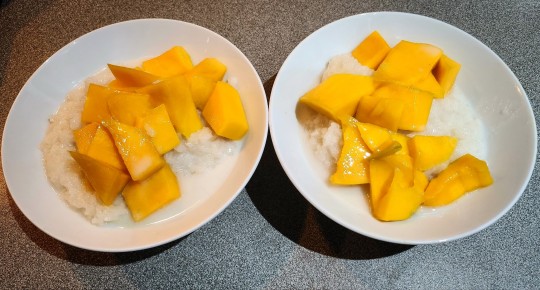
Bright-Throat Mango Sticky Rice
The Bright-Throats of Murkmire are one of the few friendly groups in the area, and their passion for cultural exchange means sharing many of their dietary customs freely with outsiders. This traditional dish is a hearty dessert that combines the juicy flavours of fresh mango with coconut milk-drenched sticky rice. A true treat for Argonian cuisine lovers!
You will need:
250g glutinous rice (you can use arborio in a pinch but Asian glutinous rice is best)
1 large mango, peeled and chopped into generous chunks
1 can coconut milk
3 tbsp coconut cream
1 1/2 tsp salt
3 tbsp sugar
Method:
Soak the glutinous rice in a mixing bowl overnight. Change the water, rinse, and cover with fresh water (about 3cm).
Cover the bowl with a plate and microwave on high for 7 mins, taking out to stir halfway through. Stir again, then return to the microwave for another 5 minutes, stirring every 2 minutes. The rice should be firm but sticky. Remove from the microwave to cool. Once at room temperature, refrigerate.
Combine the coconut milk, salt, and sugar in a pan. Bring to a simmer. Divide the chilled rice into two portions, then top with cut mango and pour on as much coconut milk mixture as you like. Drizzle with coconut cream to serve. Mix together and enjoy!
#the elder scrolls#tes#food#cooking#Recipe#Recipes#Argonian#Mango#Rice#Dessert#Thai#thai food#thai cooking#Worldbuilding#World building
190 notes
·
View notes
Text
Tonight’s Special
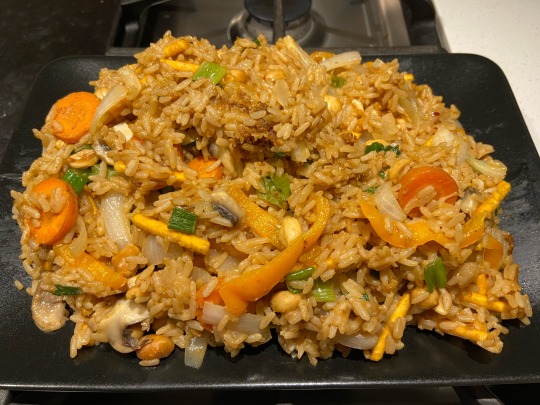
Pad-Thai peanut 🥜 fried rice 🍚
#food#foodblogger#foodgawker#foodpost#foodpics#foodgram#home cooking#cooking#rice#fried rice#pad thai#thai food#thai cuisine#thai cooking#vegetables#carrots#peanuts#mushrooms#vegetarian#vegan#onion#green onions#bell peppers
28 notes
·
View notes
Text
Alright, happy Monday! As previously promised during my review of A Tale of Thousand Stars: in preparation for the eventual release of Moonlight Chicken, I would love to share in a long manifesto my love, my passion, the GOSPEL, for what I think may be the unsung hero and character of that show, without even seeing an episode -- the actual dish of Hainanese chicken rice itself, which is known as khao man gai in Thailand.
(LONG POST! TL;DR: this post is going to contain a quick explanation of why it is SO BOMB that there’s a THAI BL that focuses ON THIS DISH, a description of the dish itself, a diasporic history of Hainanese chicken rice, links to a few recipes, and a list of places where I’ve had Hainanese chicken rice in the States.)
Borrowing a photo from Mark Wiens! Let’s get started.
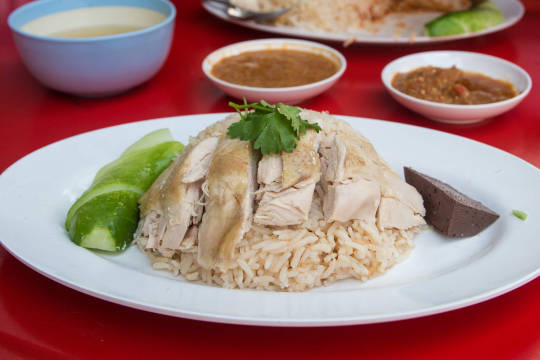
Girl, why exactly are you going off on all this?
Why, oh why, you may ask -- why should Mama Turtles wax POETIC about the seemingly simple dish of chicken rice? The simple name of the dish belies a deeply cultural symbol of so much -- of the roles that particular dishes play in Southeast Asian cultures, of how such a dish can be so difficult to make AND to relate to, and at least most importantly to me, how immigration and diasporas created the complicated and diverse foodways and cultural fabrics that we see in this part of the world.
(For the record, I’m part Malaysian, and have spent significant time of my adult life in Malaysia and Singapore. While these areas are not Thailand specifically, there’s tons of shared food preparation, culture, and appreciation from Thailand, down south to Penang and the Malay Peninsula, and down to Singapore.)
Why is khao man gai such a big deal vis à vis Moonlight Chicken?
Before I talk about the details of the dish itself, I want to set the context of why is it SO MOTHERBLEEPING LOVELY that there’s a Thai BL (with our DARLING Earth and Mix starring in it, with the DARLING First and Khao in supporting roles) that is ostensibly centered on a man making khao man gai. This is deeply heart-warming, soul-settling, feel-good shiz to me, and I think that a lot of Thai BL fujoshis who are obsessed with food, like me, would feel the same way.
Hainanese chicken rice/khao man gai is made of the most humble of ingredients -- chicken, rice, water, salt.
The fact that there would be a queer series centered around a queer man making khao man gai and selling it to others -- it means that a dish that is totally, utterly accessible to EVERY SINGLE PERSON in a country is being centered in a show focused on queer relationships....the kinds of relationships that should also be accessible to EVERY SINGLE PERSON who wants this kind of a relationship in an Asian country.
This will make even more sense as I continue writing about the dish, but suffice to say, while it’s complicated to make, Hainanese chicken rice is about the most egalitarian food there is -- and the freedom to love whoever you want should also be as egalitarian as that.
What is Hainanese chicken rice/khao man gai, and what is the big bleeping deal about it?
Before I jump to Wikipedia, maybe I should have Earth himself explain the dish.
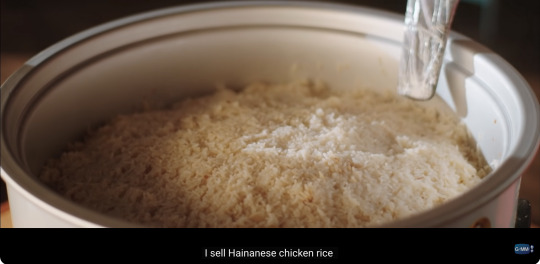


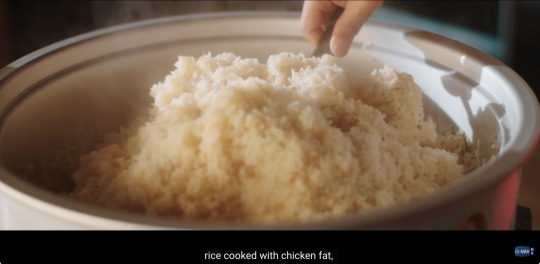
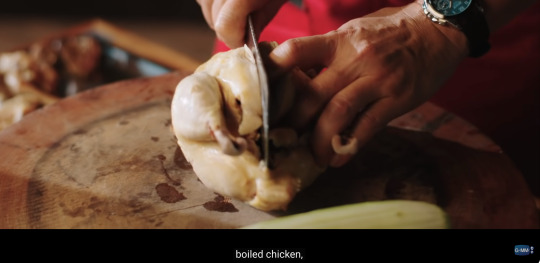
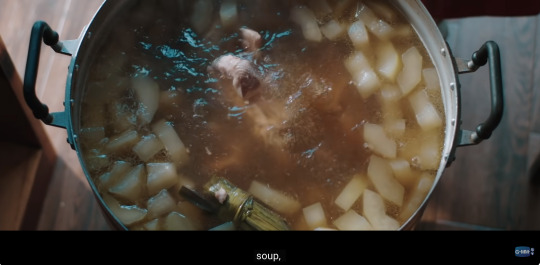


That last screenshot is truth.
Obviously, the easiest place to find a background on this dish is Wikipedia, and what I actually didn’t know before starting to type this up is that khao man gai literally means “chicken oily rice,” which totally sums up this dish. While it seems simple, it’s a very rich and filling dish, but also healthy-ish, because you’re still eating chicken, which is not the richest or fattiest of meats.
The dish consists of rice that’s first been sautéed with aromatics like ginger and garlic, and (in many, but not all cases) also sautéed with rendered chicken fat. (If you’re from the East Coast of the States or are part of a Jewish community, you’ll know this ingredient as schmaltz.)
That fatty sautéed rice is then steamed in chicken broth, ideally in chicken broth that you yourself made while you were boiling the chicken that you’ll use in your khao man gai. As far as that chicken goes, you’ve cleaned it, prepped it, maybe you rubbed salt on it to get rid of any impurities on the skin, and boiled it until it’s cooked, but not overcooked. If you’re in Thailand, you might just let it cool; if you’re in Malaysia or Singapore, or elsewhere in Asia, you might give that baby a dip in ice water after it’s done cooking, to tighten up the skin and give the skin a jellied texture that is beloved by many. You also might rub some sesame oil on your chicken after the boiling process, which is done in some, but not all, places.
You also might go wild and serve your rice not just with the boiled chicken, but also with roasted chicken, or fried chicken, or a combo of boiled/roasted/fried chicken. You ALSO might WILD OUT MORE and ALSO serve your chicken rice with, say, crispy siu yuk, which I’ve had, and like.... ooooommmmfffffgggg. It sends shivers down my spine, it’s so good.
You’ve also made the broth perfectly with aromatics, and possibly simmered either daikon or winter melon in the broth to serve alongside the composed dish of chicken and rice.
AND, you definitely best have made some side sauces. Garlic-ginger-vinegar sauce, maybe, or ginger-scallion oil, or red chili sauce, or all of them. In Thailand, a sauce that features taucu, or fermented yellow soybeans, seems to be an absolute must -- and it is goddamn pure heaven to put on your khao man gai. If you’re in Malaysia, a small dish of vinegared chili, known as chili padi, is a must must. Depending on where you’re eating this in Asia, you’ll put a bottle of dark soy sauce on the table for drizzling over all your rice, but -- you might not always see that at every place where you’re eating chicken rice.
In OTHER WORDS: this dish is a bit of a beast to make. The simple LOOK of the dish -- white chicken on top of white rice, with some sliced cucumbers to the side, and a bowl of broth next to it -- is totally disingenuous to the work you need to put in to make it taste great. Your broth, for instance, might be made by boiling chicken after chicken after chicken in it. That broth gets more concentrated and powerful over time as you’re putting in more and more aromatics in it. Your store is defined by your broth; by how perfectly each grain of rice is individually coated in a sheen of chicken fat, salt, and other seasonings; by your one-of-a-kind sauces that hit and accompany the chicken and the rice perfectly, and most importantly, by how all these components come together. If your soup, chicken, rice, and sauces are ALL PERFECTLY MADE, then you’ve hit paydirt, my friends.
It’s VERY RARE to find a shop that does all these components perfectly, or at least at the same level of tastiness.
Alright, so I get that this dish can be a motherfucker to make. But why is it such a big deal, culturally? Why would a Thai BL be focused on a guy making this dish?
So for this part, I first want to say that I think it’s very important for a Western audience to understand that this dish is deeply loved in MANY countries in Asia and Southeast Asia. I’ve eaten this dish with groups of Westerners in SE Asia -- actually exclusively white folks, now that I think about it -- and to a tee, I’ve heard complaints by them that this dish is boring and they can’t see what the big deal is about it.
I mean, American pork chops can be fine, or they can be boring, too.
The fact that chicken rice spans multiple countries and foodways should tell a Western audience that there are qualities about it, as I listed above, that are far beyond the sum of its parts. For instance -- the way to get each GRAIN of rice coated in fat and flavor takes years of experience. Y’all, I still can’t get perfect rice in my rice cooker, and I’ve been making rice for my family for more than 10 years. These things take time to perfect, and not everything one eats in Asia is going to be bombastic, like, say, Taiwanese stinky tofu or a gorgeous omakase at a high-end sushi bar.
Part of the reason why this dish is so beloved is because it IS very ubiquitous from the China-to-Southeast-Asia diaspora. I can mostly speak for Malaysia (I apologize for not knowing more about immigration patterns in Thailand), but MUCH of the fabric of Malaysian cuisine comes from specifically regional immigrant diasporas, namely from the area of China that is now known as Fujian, but that’s not a hard and fast historical rule. Well-known populations from this area in China that settled in Malaysia include the Hakka and Hokkien populations (you may have seen Hakka mee or Hokkien mee on Malaysian restaurant menus), and they also include the Hainanese population, which brought a style of boiling chicken in broth to the areas where the population settled -- which include Thailand and Malaysia, and eventually Singapore, as Hainanese descendants moved farther south down the Malay peninsula.
(By the way, if you’re ever curious, you need to read up on populations that were literally created after the first waves of Chinese immigration to Southeast Asia. The well-known Peranakan population in Malaysia, for instance, was literally created through interracial marriage of Chinese immigrants to native Malay populations, and a deeply important culture, including foodways, were born out of those marriages and population growth. It’s fascinating history in a world that often seems so hyperfocused on far right movements wanting “racial purity.” What cultural beauty comes out of populations and diasporas meeting each other and creating new cultures together.)
Back to the discussion: as Malaysian cultures and populations developed over time due in part to the influence of Chinese immigration through Southeast Asia, so, we assume, the same was happening in Thailand. (We can see deeply the effect of the influence of Chinese culture in a show like Big Dragon, which was centered around the telling of Chinese Buddhist myths through a Thai lens.) And as these immigrant populations from China traversed the Thai-Malay peninsula, their food habits stuck and were adopted by the native Southeast Asian populations. It’s no wonder that chicken rice became as beloved and ubiquitous as it did -- in part because rice is a staple food across the whole region, in part because it’s such a comforting dish (like congee, like juk, like okayu porridge), and in part because the individual ingredients themselves are humble and easy to find for your everyday home cook.
I want to just quickly touch upon the point of rice as a staple food. It seems so super obvious to us Asians, but especially for fans of QL that may not be Asian and/or may not have rice as a central and everyday food -- to make a dish like chicken rice perfectly, to have it center on the particular way in which you PREP and COOK the rice, for the rice to be all oily and salty and chicken-y -- the dichotomy of how humble rice is with how GLORIOUSLY TASTY and filling the final result of chicken rice is, can really move you. There are thousands of other rice preparations out there that are just as beloved as chicken rice -- from the Malaysian nasi lemak (literally “fat rice,” or rice cooked in coconut milk and served with delicious accompaniments) to Indian biriyani, to Japanese takikomi gohan or tamago kake gohan, to Korean bibimbap or gyeran bap -- you get the point. Dishes that center on rice are just beloved. They just are, because rice is so fundamentally egalitarian and important to our everyday way of being and eating.
AND, the way in which you EAT chicken rice -- by mixing up the accompaniments throughout the eating process, dolling up each bite of rice with a different sauce, having a sip of soup, taking a bit of meat -- that whole process of making each bite taste different allows you to have a whirlwind experience of eating with, again, very humble ingredients that end up being far more than the sum of their rice-meat-and-veg parts.
And so. When Chinese populations were immigrating throughout Southeast Asia, they brought with them, and adapted over time, a style of making rice with chicken and fat that, again, seemed so simple, but was so full of a kind of quiet and comforting flavor, that it HAD to be adapted by every country and population in which the Chinese immigrants had settled. The love for rice in the whole region was going to lead to a guaranteed adaptation of this dish for generations to cook and enjoy.
Finally, regarding Moonlight Chicken once more -- without having seen an episode yet, I want to offer some conjecture that I think (or hope) that the plot reflects the simple-but-complicated nature of the dish of khao man gai with whatever happens in the love triangles of Earth, Mix, First, and Khao. There might very well be love parallels that what seems to be simple is actually a beast to make, both in food and in relationships.
And regarding a cultural love for rice dishes, and the fact that this dish and a khao man gai establishment is at the heart of this show: it fills me up with so much comforting happiness that a khao man gai joint is what’s being used to center a theme of where people go to kick off the show. If you know of a great khao man gai joint -- you go to it, people flock to it. The trailer shows drunk people stumbling around. If you’re drunk and hungry, you want to go to a place that gives you comfort, right? That might be a McDonald’s, a taco truck, a diner, a 24-hour Korean restaurant (ugh, anju at 2 am while you’re nursing your eventual hangover...memories).
Khao man gai IS COMFORT, and IS comfort food. Earth’s character providing that comfort...I’m just saying, there HAS to be parallels between khao man gai and the storyline of Moonlight Chicken. THERE MUST BE. Let a girl dream!
Damn, girl. You went OFF. Take some Altoids. Give us some recipes!
Yes, this is definitely a manifesto of manifestos of an amazing dish.
These recipes mark the cultural landscape of this dish. I’ll note where the recipe comes from. I encourage you to review these recipes and check out the small-and-large differences in how this dish is made, depending on where in Asia the recipe is centered. (For instance, many of these recipes call for that ice bath that I mentioned earlier; that’s not ubiquitous in Thailand.)
Also, I want to note that as far as the side soup goes, I’ve only seen that Thai preparations of khao man gai GUARANTEE the soup on the side. I’ve seen some places in Singapore offer the side soup, but not all. The addition of daikon or winter melon to the soup, in Thai preparations, gives me the shivers, it is so good. So if/when you’re making this at home, keep in mind that you can choose to serve the broth/soup on the side.
Two last notes -- this coming from me, a mom and busy home cook. I sometimes do a very bastardized version of this dish for my kids, where I poach chicken in aromatics, but I don’t sauté the rice beforehand -- I just chuck the rice in my rice cooker with my poaching liquid. When I do this, I always freeze a half-quart to a quart of broth. Then, when I make the dish again, I take out that frozen broth, add it to my pot with my new chicken and water, and start poaching again. Having that base of previous broth really DOES help make my future chicken and soups taste that much richer.
AND -- while I have daikon available in my supermarket (thank you, big cities!), I often use turnips as the veg that I serve with the broth. I LOVE turnips in soup, y’all! Turnips in chicken soup are oniony without being overwhelming, and I love how translucent and creamy they get. They totally hold the flavor of broth beautifully. Next time you’re making soup, don’t leave the turnips behind, they’re great! (Oh, and also, a tip I learned from the Kinou Nani Tabeta mangas -- I also use leeks as an aromatic in my soup, along with garlic and ginger. Leeks are AMAZING in soup! They can help take away any gaminess you might get from poaching chicken or other meat.)
Okay, recipes!
The Woks of Life (China)
Food 52 (Thailand)
Mark Wiens (Thailand)
Rasa Malaysia (Malaysia)
Adam Liaw (Singapore-ish recipe, note the use of sesame oil for rubbing on the chicken after the ice bath -- not all recipes call for this)
Kwokspots (maybe we can call this a ubiquitously Asian recipe? I actually just love this dude on IG, I’m gonna hype up his recipe)
Um, this is a lot. Where can I order this dish?
In my post about A Tale of Thousand Stars, I referenced Eim Khao Man Gai in Elmhurst, Queens, NY (see footnote below). I unfortunately only know places to eat Hainanese chicken rice/khao man gai in either NY or SoCal, but I ENCOURAGE you to please seek it out wherever you live.
Over the years, even while I’ve lived thousands of miles away from New York, Eim Khao Man Gai is my restaurant par excellence for khao man gai. It’s all they serve, and they do it SO well. Eim Khao Man Gai also does their chicken three ways -- steamed, roasted, and/or crispy. You guys, it’s just heavenly, and their side sauces are to die for.
In SoCal, Savoy Kitchen was the first place I heard of that specialized in chicken rice, and it’s incredible here. As well, I love Side Chick at the Westfield Santa Anita mall in Arcadia. I’ve eaten a bunch at Ipoh Kopitiam in Alhambra, but I haven’t tried their Singapore-style Hainan chicken rice yet -- it looks amazing, and many reviews say that it’s currently best version in the San Gabriel Valley.
Back to New York for a second -- if you’re looking for a place more local to you that isn’t in Queens, just look at Yelp. If I lived in NYC now, I would be in tears with how much more available this dish has gotten over the years.
Wherever you are in the States -- the Bay Area, Texas, anywhere where there are significant Asian populations -- or wherever you are in the world, please seek out Hainanese chicken rice/khao man gai. Again, it may not LOOK exciting on the menu. But you’ll get a taste for the kind of comfort food that really hits home for so many of us Asians.
Holy shit. You must be exhausted!
WOW WOW WOW, y’all. If you’ve gotten THIS FAR -- bless you! Thanks for going on this road with me. Please make, buy, and/or eat Hainanese chicken rice/khao man gai. Appreciate the differences of the dish from each of the cultures that you’re eating it from. Please give big hugs to GMMTV for focusing a BL on this most humble, beautiful, delicious, soul-satisfying dish. I’m hoping for all the food/love parallels. I’m dying to see Mix just snarf on a big plate of khao man gai to kick the series off.
Moonlight Chicken is gonna be SO GREAT! And chicken rice is just the best dish ever. Please enjoy it!
* * *
If you have the energy to read a little further, one more urge from your devoted food mom here. @secretsfromwholecloth noted in a comment on my ATOTS review that ae and aer friend had actually hit up Eim Khao Man Gai, which was SO RAD to read. If you have never visited NYC before, and you’re plotting your itinerary of the usual tourist stops -- I beg you to please save at least an afternoon to hop on the 7 train and head out to Queens. Queens has some of THE BEST RESTAURANTS in NYC. From Indian and Tibetan in Jackson Heights, to Thai and Filipino food in Elmhurst and Woodside, to Greek in Astoria, to Korean in Bayside and Flushing, and the monolith that is Flushing’s Chinatown -- Queens is the happiest and fucking coolest diverse place in the world. Don’t be afraid to leave Manhattan for an afternoon or even a whole day. Eat everything during the day, hit up Flushing Meadows Corona Park for some exercise, check out the Queens Museum and the awesome Noguchi Museum, unwind at a cocktail bar in Long Island City or Sunnyside at night. Queens is totally the unsung best borough in NYC, one of the most diverse counties in the States, and I’ll stand up for Queens County every minute of my life over Manhattan.
#moonlight chicken#a tale of thousand stars#earth pirapat#mix sahaphap#earthmix#khao man gai#hainanese chicken rice#cooking#thai cooking#malaysian cooking#singaporean cooking#hainan#foodways and diasporas#chinese diaspora
178 notes
·
View notes
Text
Thai Food You Should Eat Because of BL

Firstly most of these dishes have multiple spellings in English (and also often many different names within Thailand). I just picked one spelling, that will be enough to do a search, if you want to find a recipe for yourself.
Som Tum in What’s Zabb Man

AKA Green Papaya Salad
I think this is the one most people will know on this list. Unlike overseas, in Thailand there are many varieties of som tum (I’ve had an ocean-side version served with little blue crabs, raw and in the shell, AMAZING). It’s often a street food, and it’s usually quite spicy. You order by either asking the vendor (it’s traditionally served from market stalls just as we saw at the beginning of this show) for a heat level or number of chilis. The ingredients are then pounded together with a massive mortar & pestle. The order and amounts of the different ingredients are chef-specific, so the variety and uniqueness is immense with this dish. There are fans of it who make a point of trying as many different versions in each city they visit. Like being a wine taster.


Som Tum highlights what I think is best about Thai food - it’s bright forward freshness and deep complexity of flavors. Som Tum is the firework-in-your-mouth of salads: sour, sweet, salty, spicy, umami, herbaceous. It’s a spectacular dish (which has been ill served by it’s ubiquitousness outside of Thailand). It should be made fresh, (this is NOT a slaw), because if it sits at all the elements become soggy and the flavor muddled.


What’s Zabb Man emphasized the important aspects of this dish. Its spiciness and its freshness, the uniqueness of its flavor, not to mention how each chef makes it his own.
After all when Poon goes missing, Athip finds him again because, after one taste of his Som Tum, he knows who is in the kitchen.
Kao Soi in Bite Me
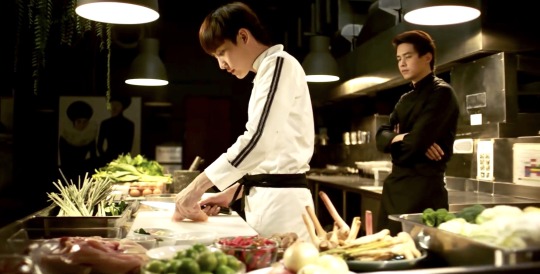
AKA Northern Thai Curry Noodle AKA Chiang Mai Curry Noodles
Did I do this post because I want to talk about this dish? Probubly. Here in the states it’s a rare to find on offer but it’s one of my absolute favorites.
I’m obsessed with diaspora foods in general - AKA fusion foods that highlight immigrant, colonial occupation, and/or blended communities. Lamb Vindaloo and Banh Mi are some famous examples of this. There was one banh mi place I found in Nor Cal run by a Chinese/Vietnamese couple that made a char siu pork + pâté banh mi, it was WILD and wicked good! Sorry, I digress.
This is a Northern Thai dish, common in Chang Mai, influenced by both Burmese (Myanmar) cuisine and local Chinese communities. It’s wildly variable by family and by region. This is also possibly one of my favorite foods. It’s notable in that it is one of the few traditional Thai dishes you will find served with chopsticks. (When I order it here in the states that’s one of the things I look for.)
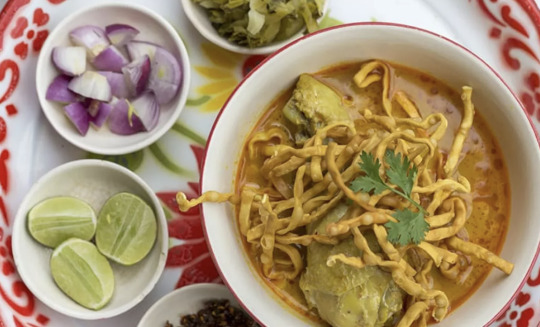
It is a noodle soup/stew. Can be rice, egg, or flour noodles, usually ramen style (but sometimes fettuccine), topped with a thick coconut forward curry broth, stewed dark meat chicken (usually on the bone) and raw onion. It has fried crispy flour noodles on top and is served with pickled vegetables, extra spices, fresh herbs, lime wedges, and raw shallots (or some combination thereof) - either on the top or on the side (banchan style). The curry element usually has more in common with Chinese or Japanese yellow curry powers (like those used for Singapore noodles) than red or green Thai curries. It combines what we would think of as traditional Thai flavor profiles with Chinese, and can also uses some Indian spices. It is a very layered dish, with more depth and earthiness and slightly less brightness than a lot of other Thai food. It tends to have a rounded heat to it (hitting all of the mouth, like Indian cuisine). I am a particular fan of the pickled greens element.
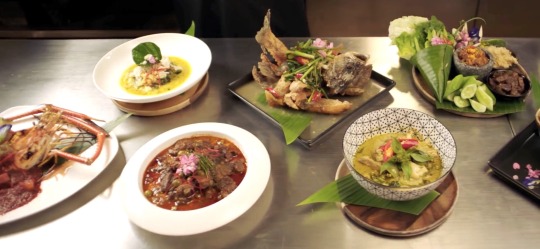
Bite Me is not a great BL but Aek sharing his Chiang Mai roots with Chef Aue, most specifically around this dish, is key to the plot (what little there is). But this is not a dish that is served in Chef Aue’s restaurant.
Khai Palo in Enchanté

AKA 5 Spice Pork & Egg Stew
This is the dish Theo remembers from his childhood that Akk’s family cooks for him. It’s a fascinating dish because it’s retains a very strong Chinese influence and is noted for using soy sauce as its salt element (rather than the more ubiquitous fish sauce) and for NOT being spicy, also it involves 5 spice.
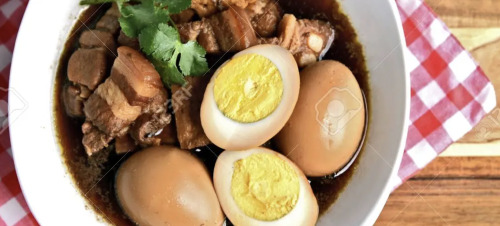
It’s also often associated with children or childishness and comfort food. It’s most commonly found as a street food or homemade, and is relatively rare in restaurants outside of Thailand. It has a similar flavor profile to Moo Gratiem which is one of my favorite dishes. (It’s that white peppercorn and garlic thing = NOM.) It’s also very easy to make, I recommend it. There is a Mama ramen noodle version you can sometimes find and buy, but I always need to add more five spice.

In Enchanté this dish is a plot point and is interesting because it highlights both the time when Theo was last in Thailand (as a child), Akk’s interest in courting and caring for him, and Theo’s somewhat childish nature/behavior.
Gaeng Tai Pla in Close Friend 2
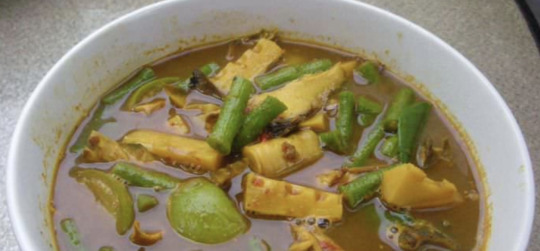
AKA pickled fish sour soup
A famous dish developed in the fishing communities of Southern Thailand. Traditionally it involves pickled fish bladder (Tai Pla) + large chunks of dried fish meat, Thai eggplant, bamboo shoots, and/or seasonal greens, with a spice profile similar to tom (lemongrass, lime, shrimp paste, red chili).
I've never been lucky enough to eat this, but it's on my hit list. I think I could make something like it, but I can’t get hold of the the Tai Pla for love nor money.
Luk Choup in La Cuisine (& Until We Meet Again)

AKA no other name, really, but this is also the main characters name in La Cuisine, ลูกชุบ (translation, coated pieces) but the meaning of this dessert is “loved by all, or adored.” This aspect of the name is a plot point in the series. Choup’s older brother, aunt, and grandmother all refer to him as the family’s beloved one, or special one, or most loved.
Luk Choup are tiny imitation fruits/vegetables (or occasionally star shapes) these are made of mung beans cooked with coconut milk and sugar. Once formed, they are dipped in gelatin and painted with food coloring to resemble other food. Recipe here.

This one appeared multiple times in Until We Meet Again, on the bus, at the fair, and at the very end during Dean and Pharm’s separation.
I’ve eaten these.
Consistency wise the exterior is like a gummy but much tougher, and with a bite to it. So like if you made jello into sheets but with too much gelatin. I’ve actually never had anything else to compare to this texture, perhaps like some of the bits in bubble teas? The interior is like very thick humus meets the inside of a peanut butter cup.

As for taste, the gel outside has no flavor and the inside tastes a lot like red bean paste. They are not very sweet.
Here’s a YT vid on how to make these.
Chor Muang in Until We Meet Again

AKA Blue Flower Dumpling
Chor Muang is a purple or blue flower-shaped dumpling that is savory, stuffed with a spiced minced chicken. These days it is a popular appetizer but it was once served as a dessert. The coloring is done with butterfly pea flour. Recipe here.

Chor Muang is a major catalyst food for the plot of Until We Meet Again. It is featured in a play starring Del and Manaow and is the reason Pharm meets and befriends Del. This allows him to start helping fix Dean’s strained family dynamic.

Later he feeds this dumpling to Team, Win, and Dean in front of witnesses. This is the first time he feeds Dean (it will not be the last.)
I did a post all about the sweets in this show. Here’s a YT vid on how to make these.
Nom Yen in SOTUS (also 2 Moons, 2 Moons 2)

AKA Pink Milk
Pink milk is pretty ubiquitous in most Thai BL series. Technically, its origin for association with BL is the original y-novel of 2 Moons. However, most international watchers are familiar with it from SOTUS (more recently it has shown up associated with side characters in Nitman and Love Area).

After watching SOTUS and both 2 Moons installments I got curious. Here’s the full post I did on pink milk, how it’s made and my experience attempting to recreate it. I can see why it might be thought of as a childish drink, it reminded me a bit of birthday cake flavoring, ice cream bean, or cotton candy. It’s very sweet and not a whole lot else.

THAI LANGUAGE CORNER
I haven’t learned the minutia yet but around ordering food in Thai but the Thai bestie always complains the monikers (also verbs?) for dishes have to do with what the dish is usually served inside. So some dishes have names/consumption verbs that have to do with bowls and others with plates.
Much as in English we would use the verb “drink” for broth but “eat” for soup. (And also argue about which one is appropriate under which circumstances.)
To train your ear for BL food:
gin = to eat or to have a meal (also under certain circumstances/sentence structures is slang for to sexually consume or fuck). See Pharm misuse this one in UWMA when Dean first visits his condo.
khao or kao = food but also actually rice, also a name and also third person he pronoun
talay = the ocean and also mixed seafood and a name
pad = usually means a stir fried (dryer) dish
pak = veggies!
kai (sounds like gai) = chicken ไก่ but also egg ไข่ (yes they are different in intonation and spelling, but really I find it darn near impossible to hear the difference)
A list of some common dishes is here.
Please leave a comment if any other dish has shown up you want to talk about, because this is basically my favorite topic EVER. I love to eat and cook Thai food so, yeah. Also the oft mentioned Thai bestie is an AMAZING cook. I often act the part of her kitchen goblin.

(source)
#thai food#thai cooking#thai bl#thai dishes#thai lanaguge#thai words#SOTUS#2 Moons#Nitman#Love Area the series#2 Moons 2#Until We Meet Again#Blue Flower Dumpling#Luk Choup#La Cuisine the series#Close Friend 2#Enchanté#bite me the series#noodles#What’s Zabb Man#Green Papaya Salad#food in bl#food in thai bl#plot point food
315 notes
·
View notes
Text
Thai cuisine 🍲 - is there any other place that so subtly combines flavors in a harmonious dance of spicy 🌶️, sour 🍋, sweet 🍯 and salty 🧂 in every bite?
It's not just about the searing chili or the aromatic herbs. It's about the heart ❤️ and soul 🙏 that locals put into each dish, setting Thai cuisine apart on the world 🌍 gastronomic stage 🏆.
Let's dive deeper - check out this list 📜 of the most popular Thai dishes you can (or should) try on your trip to Thailand 🇹🇭. Read article - https://travelingvibe.com/food-in-thailand-popular-thai-dishes
Website | Pinterest | Instagram | Facebook | Twitter
#cooking#thailand#cuisine#Thailand#ThaiFood#ThauCuisine#ThaiDishes#food#asian food#thai food#thai cuisine#thai cooking#thai curry#thai culture#tourism#food tour
2 notes
·
View notes
Text

Moon Gate ,, JiaTongHeng is a One Michelin Hat rated Chinese-Thai fusion restaurant in Chiang Mai. Located in the arcade of One Nimman, more to follow in next. 🙏
2 notes
·
View notes
Text
ไก่ตุ๋นซีอิ๊ว สูตร เนื้อไก่นุ่ม ฉ่ำ หอมพริกไทย เมนูข้าวหมดหม้อ ( Stewed Chicken with Soy Sauce )
youtube
#thaifood#foodie#phungkangyummy#food#stewed chicken#chicken#thai food recipe#thai cooking#ไก่ตุ๋นซีอิ๊ว#easy recipes#Youtube
2 notes
·
View notes
Text

Lunchtime at Thai food restaurant! I got the pad thai on the top right, loved how they added so much bok choy
#bok choy#thai food#pad thai#noodles#food#delicious#thai cuisine#rice#vegetables#veggies#foodblogger#foodblogfeed#foodblogeats#food diary#foodstagram#foodie#thai cooking
2 notes
·
View notes
Text


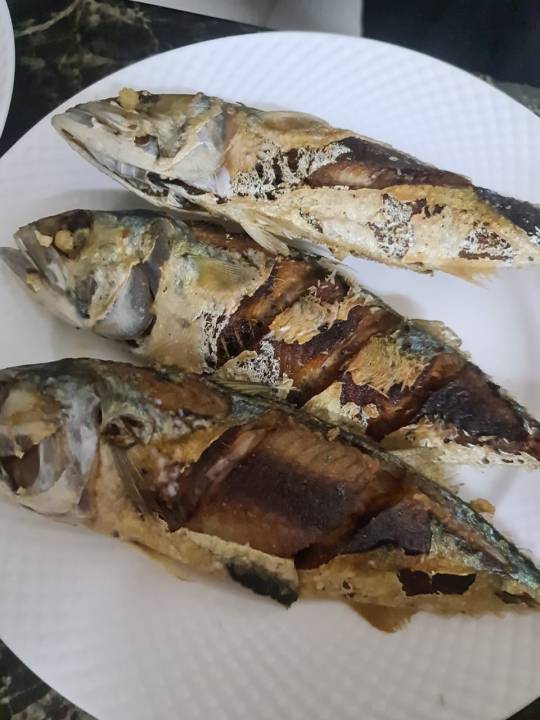
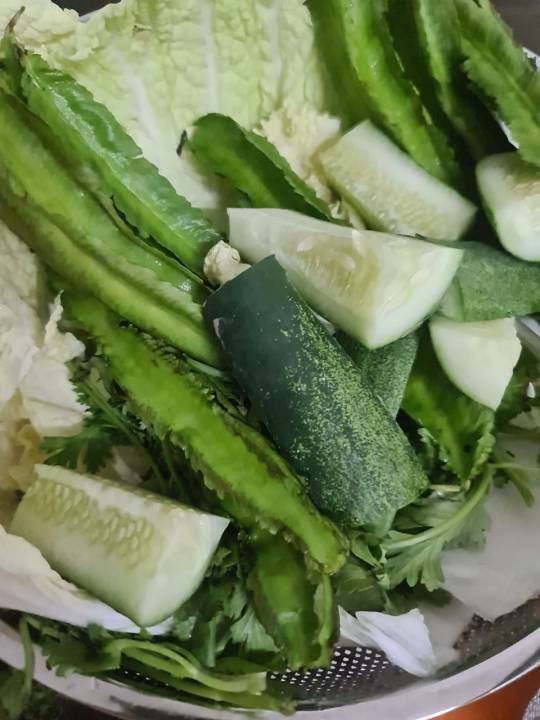



Thailand food
#youtube#malaysia#australia#love yourself#positivity#beachvibes#indonesia#singapore#architecture#canada#thai tea#thailand#thai guy#thai bl#thaitattoo#digitaltv thaitv#muay thai#thai cooking#thai language#thai lady#africanfood#africa#afrobeats#there are plenty to shop eat and play at our latest lifestyle mall! with more than 100 brands and... genting highlands 69000 kuala lumpur ma#thai lakorn#thailog#thai recipes#thai restaurant#thai drama#thai beauty
3 notes
·
View notes
Text
THAI CARROT AND SWEET POTATO SOUP
It is not that common for me to rave about a soup, but this one leaves me no other option. Absolutely delicious, super simple to prepare, just a few ingredients give it a lift from the humble to extraordinary. I modified it quite a bit to accommodate food sensitivities, but whatever you do, do not change the almond topping. Tamari-Roasted Almonds. Superb!
THAI CARROT AND SWEET POTATO SOUP WITH…

View On WordPress
0 notes
Video
youtube
(via Chiang Mai, Thailand: Cooking School | John Rachel) Masumi and I got an introduction to how to prepare Thai food during our recent visit to Chiang Mai. Truly unforgettable!
0 notes
Text
Tonight’s Special
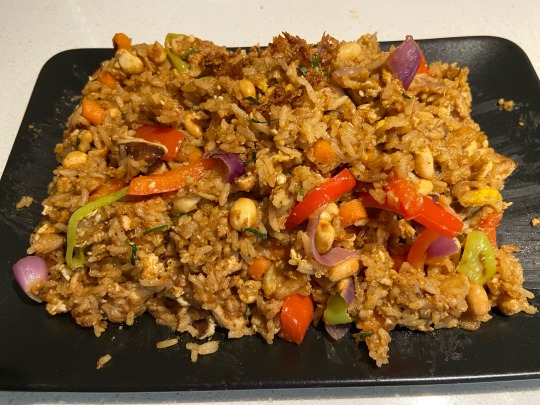
Pad Thai chicken fried rice
#food#foodblogger#foodgawker#foodpost#foodpics#foodgram#home cooking#cooking#rice#fried rice#chicken#pad thai#chicken fried rice#peanuts#peanut sauce#veggies#dinner#asian cuisine#thai cooking#fusion#oriental cooking
1 note
·
View note
Link
Check this out... https://u6763876.ct.sendgrid.net/ls/click?upn=aDCUBe-2BhaiJZ-2B4-2BA5-2B720NjogjrXCHHSIJR1Coy2kwywZc9VJHtHoQMh-2BefiPHiegfZ3kEufXS-2FPt8EmEXmrMw-3D-3D1y0t_4jGl5NHZJnWoTjOgRA72nBfw7ROiSTGOrV0PbW80rg2l2L674tYpsldzxQlPC-2BTBQQMxVoq0LPmggHZ28pvGq-2BQ8INgdKzv6aQoHEKiiW0DEK74R5msti4NrbK3D-2BTgFbD9-2Bx1yqK-2FROip7dRCsbuBzbyWaE8rbQZsgFfhwhqu7zdHa8qhVYhwOduLCHPy1d0wpzsJKK-2FWltl-2B2hJ-2FW3M4qSOC1khR6QTE8n4tiC4oo-3D
0 notes
Text
Essential Food Ingredients in Thai Cuisine
Thai food could appear tough to create at home due to its well-known taste combination of sweet, salty, sour, and spicy, but this couldn't be further from the truth. Although some of the basics of Thai food require a special effort to find, your senses will be rewarded handsomely. Find out more about galangal and Thai chilies, two of the holy grails of Thai cuisine.
Read 11 Essential Ingredients of Thai Cooking, to know more.
Website: zanethaiproducts.com
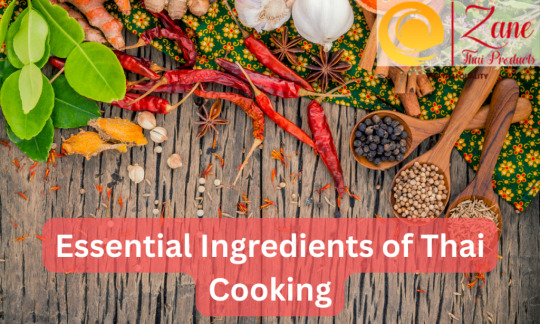
Thai herbs include Thai basil, mint, lemongrass, galangal, and cilantro. Thai basil has a sweet and aromatic flavor, while mint has a stronger licorice or anise taste. Lemongrass is woody, aromatic, and lemony, while galangal is smooth, light, and creamy with black striations. Galangal is used to give soups and curry pastes a vibrant taste. Galangal (Kha) is a less hotly spiced relative, adding a spicy, citrus-like zing to soups and stir-fries.
Thai chilies are thin, tiny, and extremely fiery, and can be frozen or kept in the refrigerator for up to a week. Kaffir lime leaves are used to naturally flavor meats, marinades, salads, dressings, and dipping sauces with hints of salt and acidity. Palm sugar is used to give sauces and pastries a smokey, butterscotch flavor. Palm sugar, coconut milk, sticky rice, jasmine rice, and rice (khao) are all essential ingredients in Thai cooking. Palm sugar provides woody and earthy overtones, while coconut milk provides a creamy sweetness.
These were some of the Thai food ingredients that are quite commonly used in Thailand. The good news is that even if you don't live close to a Thai market, you can still purchase Thai food online, including the aforementioned Thai food ingredients.
#Thai cooking#Thai food dishes#Thai food ingredients#buy Thai food online#Thai snacks#Thai Fruits#Zane Thai Products
0 notes
Text
Thai Cooking :: Jennifer Brennan

View On WordPress
#0-9069-0863-9#asian cookbooks#bangkok cuisine#books by jennifer brennan#cookery#cuisine thai¨landaise#first edition books#gaeng chud#gaeng ped#gai lae pet#neua#roasting#siamese cuisine#thai cook books#thai cookbooks#thai cookery#thai cooking#thai cuisine#thai curries#thai dishes#thai recipes
1 note
·
View note
Text
Tom Yam Soup - exploring the iconic Thai dish

🔥 Embark on a Culinary Adventure with Thailand's Iconic Tom Yam Soup! 🌶️🍲 Read - https://travelingvibe.com/tom-yam-soup
Hello, food aficionados and Tumblr community! Today, we're thrilled to unveil a deep dive into one of Thailand's most celebrated culinary treasures - Tom Yam Soup. This isn't just any soup; it's a symphony of flavors that captures the essence of Thai cooking.
🌟 Unveiling the Magic of Tom Yam Tom Yam, known for its distinctive hot and sour profile, is a testament to the complexity and richness of Thai cuisine. Our feature article takes you on a sensory journey, exploring the intricacies of this beloved dish. From the fragrant lemongrass to the fiery chili, each ingredient is a key player in creating Tom Yam's unique taste.
🍃 A Blend of Tradition and Taste We delve into the traditional roots of Tom Yam, showcasing how this timeless recipe has evolved while retaining its cultural significance. Learn about the different regional variations and how each adds its own twist to this classic soup.
👩🍳 Cooking Up a Storm For the aspiring chefs and culinary enthusiasts, our article includes expert tips on how to recreate authentic Tom Yam at home. Whether you're a beginner or a seasoned cook, these insights will elevate your cooking game and bring a taste of Thailand right into your kitchen.
🌏 More Than Just a Dish Tom Yam is more than just a soup; it's a culinary icon that represents Thai people's love for harmony in flavors. We explore the cultural importance of Tom Yam in Thai society and how it has become a global phenomenon, loved by foodies worldwide.
🥣 Join the Tom Yam Tribe Get ready to immerse yourself in the rich, tangy, and spicy world of Tom Yam. Whether you're a long-time fan or new to Thai cuisine, our article will ignite your passion for this incredible dish. Don't miss out on this journey of taste, tradition, and tantalizing aromas.
Follow us for more culinary explorations and discover the world through its flavors. Let's celebrate the art of cooking and the joy of eating together!
Website | Pinterest | Instagram | Facebook | Twitter
0 notes